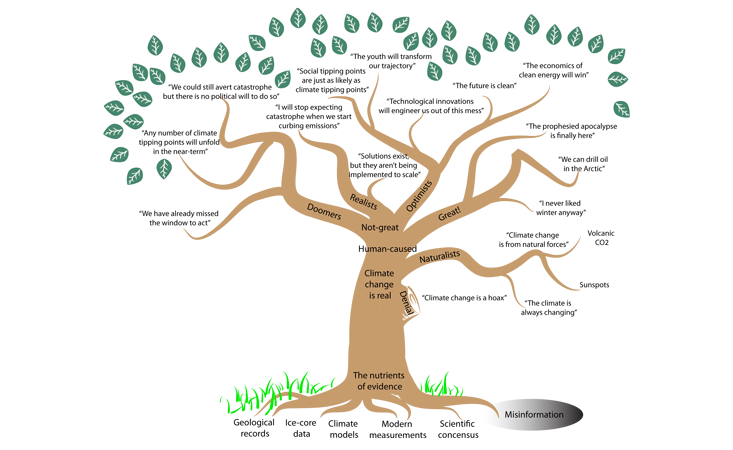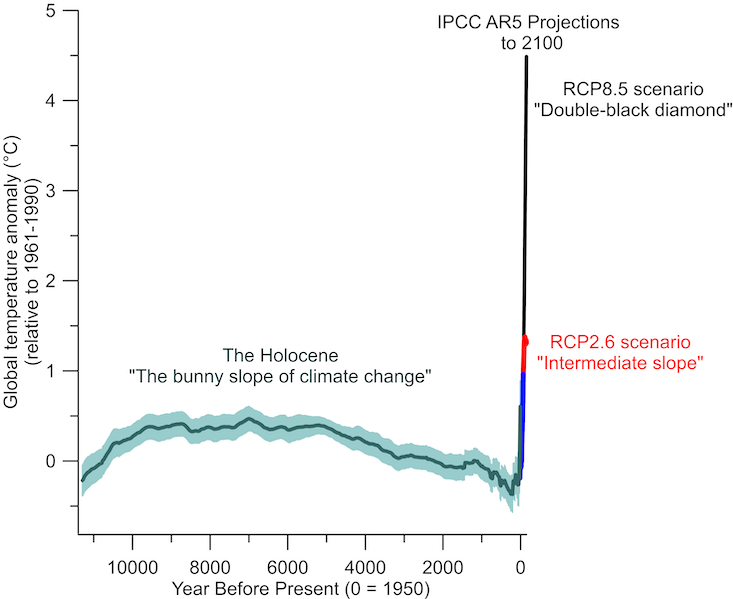As a paleoclimatologist, I often find myself wondering why more people aren’t listening to the warnings, the data, the messages of climate woes—it’s not just a storm on the horizon, it’s here, knocking on the front door. In fact, it’s not even the front door anymore. You are on the roof, waiting for a helicopter to rescue you from your submerged house.
The data is clear: The rates of current carbon dioxide release are 10 times greater than even the most rapid natural carbon catastrophe1 in the geological records, which brought about a miserable hothouse world of acidic oceans lacking oxygen, triggering a pulse of extinctions.2
Despite the evidence for anthropogenic climate change, views about the severity and impact of global warming diverge like branch points on a gnarly old oak tree (below).

The first split is between deniers and acceptors; only the denial branch doesn’t go anywhere—it’s just a dead stump, no longer sustained by the nutrients of evidence. The next bifurcation is on the root cause of climate change. Naturalists say “the climate has always changed,” which aside from ignoring evidence that the recent increase in carbon dioxide is from burning fossil fuels,3 is a diversion tactic for derailing meaningful conversations by stating the obvious. Of course, the climate is always changing; the relevant variable is the rate at which it does so.
If we follow the branch line that accepts the evidence for human-induced climate change, the next major split is between those who see global warming as a good thing and those who view it as a bad one. The former view an ice-free Arctic as a business boon for oil extraction or sweltering cities as an expanding market for air conditioners, or they are your clueless uncle joking about his property going up in value because it will suddenly be beachfront property.
Alarmists are labeled “Cassandras of doom.” But Cassandra was right. The problem is she was ignored.
This view is perched on a naïve premise that stability still prevails even amid the progressive undercutting of the systems that make it possible. It neglects the fact that accelerating the rates of change makes the probability of crossing thresholds far more likely.
If you keep following the branch points higher and higher, you come to a split in the messaging around the outlook for the future. This might even be between two climate scientists with similar backgrounds—some of whom are struggling with ecological grief4 and depression over dying coral reefs and the world their children will inherit, while others seem to always keep their chin up, adamant that the only way to communicate and solve the problem is to make sure it is wrapped in a bow of positivity.
The divergent outlook of the future is like the old geological battle of gradualism versus catastrophism. Gradualists asserted that it was slow and steady processes like erosion that shaped the earth. Catastrophists pointed to extinction events in the fossil record as evidence for episodic events that punctuated the status quo and completely altered Earth’s bio and geo-spheres—events like asteroid impacts or volcanism-induced carbon catastrophes. Both, it would turn out, were right. They were just pointing to different periods in Earth’s history—different slopes on the graph—adamant that they had the proof to back up their claim.
If we were to consider this dualism in terms of personality, we would all fall somewhere on the spectrum of gradualist to catastrophist. Gradualists expect more or less steady rates of change. They have money in the stock market; trust in stability. They are inclined to believe science will engineer a solution to climate change. Catastrophists have a healthy respect for the unexpected. They store their money in gold and bury it under the apple tree, viewing any day as ripe for collapse: earthquake, stock market, tsunami, bolide. Catastrophists are not patient people.
The divergent outlook of the future is like the old geological battle of gradualism versus catastrophism.
The fact is, climate change will come both slow and steady as well as fast and furious, reflecting the long-term average changes in global temperature and the short-term extremes that will continue to get more and more outrageous as the system absorbs energy. The last five decades have been to some extent slow and steady because the oceans have absorbed so much of the excess heat energy,5 buffering us from the brunt of it. This has likely contributed to a false sense of security for those who don’t know the climate system is riddled with thresholds and tipping points,6 thinking that future changes will unfold just as gradually as the past.
But all that heat is now fueling massive storms and generating marine heatwaves that can take down entire ecosystems in shockingly abrupt timescales. Slow erosion can give way to sudden failure. The last five years have given us a taste of the fast and furious. In these fives year, we have witnessed the collapse of coral reefs,7 the collapse of the California kelp forest,8 wildfires9 and hurricanes10 of unprecedented proportions. These are local catastrophes unfolding in real time to the occupants of these regions, their lives already divided into before and afters, much like a geological timeline.
If there is one lesson we should heed from Earth history, it’s that thresholds become far more likely as the rates and magnitude of change increase. And the danger of thresholds is that they are effectively one-way doors: easily walked through and closed to re-entry. This is the time-asymmetry of instability: It takes much longer to establish stability than it does to unravel it.
Rates may be the simplest and most critical aspect of climate change to understand, and yet it is not something that most people likely see on a regular basis. When I talk about rate, I take for granted that I am conjuring an image in my mind the whole time, in part because I stare at graphs of climate history every day. All those stories of ecological catastrophe are compactly folded up into a single near-vertical line on a graph. That’s when you know you’re in trouble: when the slope suddenly goes vertical (below).

For many climate scientists, the awareness of being on the knife’s edge of the graph, plotting steeper and steeper every day is like learning to live with vertigo, partitioning off a deep sense that we are no longer on stable ground while simultaneously trying to get on with the day, show up to work, laugh with our kids.
Those who warn about potential instability have always been labeled “Cassandras of doom.” There’s an irony to this because Cassandra was right. She was just ignored as an “alarmist”— that dirty word now cleverly used to emasculate anyone concerned about climate change into the category of “hysterical woman.”
The thing about alarms is that they turn out to be useful. The canary in the coalmine, smoke detectors, tornado sirens, cell phone alerts; we generally agree that instruments to detect and convey impending threats are a step in the right direction. In fact, we require them in most buildings. The inconvenience of an occasional false alarm is far outweighed by the benefit of not dying in your sleep by a raging fire.
So while catastrophists may get the eye-roll of hyperbole, gradualists warrant an occasional head-slap of naivete. Their apparent inability to conceive a fundamentally different world leads them into a default mode of complacency, one that ironically makes it much more likely to provoke the thing they aren’t expecting. On the flip side, catastrophists are more prone to expect disaster, and might be more motivated to prevent the potential threats. So each will unwittingly prove the other one right, if they have their way of things.
What if instead of feeling threatened by differences in opinion, we were to reconceptualize them in much the same way a tree will distribute a canopy to collect as much sunlight as possible—as a multi-pronged approach to getting the job done? In the same sense that both fast and slow processes contribute to Earth change, both steady progress and immediate local action will contribute to climate solutions. Let’s take stock of our pace and work together, thankful there is someone else to fill the space we can’t. After all, we are not lone trees, but a living, connected forest, and balance is essential for stability.
Summer Praetorius is a paleoclimatologist who studies the dynamics of abrupt climate change.
References
1. Cui, Y., et al. Slow release of fossil carbon during the Palaeocene-Eocene thermal maximum. Nature Geoscience 2, 481-485 (2011).
2. McInerney, F.A. & Wing, S.L. The Paleocene-Eocene thermal maximum: A perturbation of carbon cycle, climate, and biosphere with implications for the future. Annual Review of Earth and Planetary Sciences 39, 489–516 (2011).
3. “How Do We Know That Recent CO2 Increases Are Due to Human Activities?” RealClimate.org (2004).
4. Cunsolo, A. & Ellis, N.R. Ecological grief as a mental health response to climate change-related loss. Nature Climate Change 8, 275–281 (2018).
5. Cheng, L., Abraham, J., Hausfather, Z., & Trenberth, K.E. How fast are the oceans warming? Science 363, 128-129 (2019).
6. Lenton, T.M. Climate tipping points—too risky to bet against. Nature.com (2019).
7. Hughes, T.P., et al. Global warming impairs stock–recruitment dynamics of corals. Nature 568, 387–390 (2019).
8. Rogers-Bennett, L. & Catton, C.A. Marine heat wave and multiple stressors tip bull kelp forest to sea urchin barrens. Scientific Reports 9, 1–9 (2019).
9. Park, W.A., et al. Observed impacts of anthropogenic climate change on wildfire in California. Earth’s Future 7, 892–910 (2019).
10. Trenberth, K.E., et al. Hurricane Harvey links to ocean heat content and climate change adaptation. Earth’s Future 6, 730–744 (2018).
11. Marcott, S.A., Shakun, J.D., Clark, P.U., & Mix, A.C. A reconstruction of regional and global temperature for the past 11,3000 years. Science 339, 1198-1201 (2013).
12. GISTEMP Team. GISS Surface Temperature Analysis (GISTEMP), version 4. NASA Goddard Institute for Space Studies (2019).
13. IPCC Climate Change 2013: The Physical Science Basis. Contribution of Working Group I to the Fifth Assessment Report of the Intergovernmental Panel on Climate Change Stocker, T.F., et al. (Eds.) Cambridge University Press (2013).























